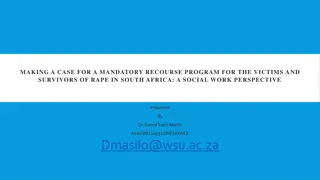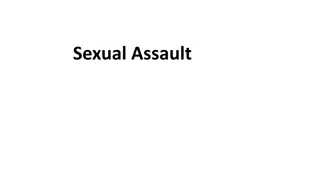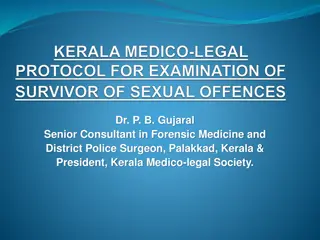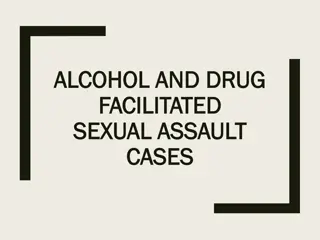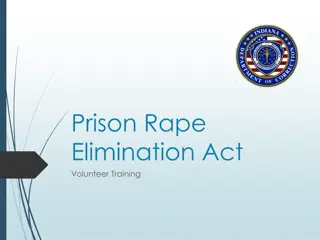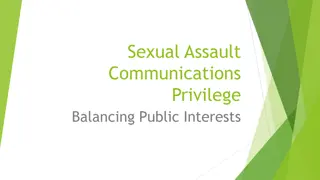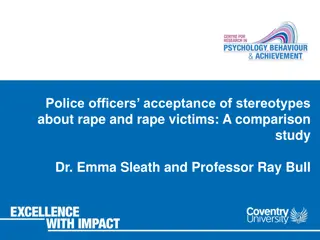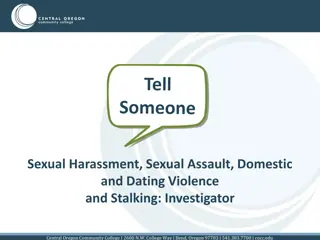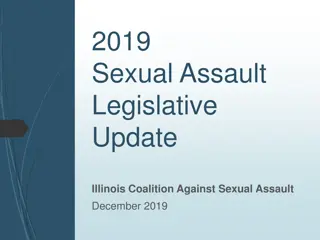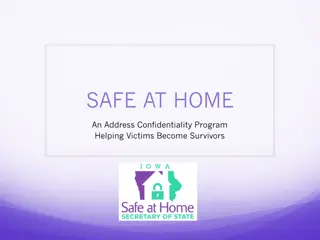Clinical Care for Survivors of Sexual Assault/Rape: History-Taking and Examination
This session focuses on providing clinical care for survivors of sexual assault/rape, emphasizing the importance of history-taking, examination, and appropriate responses. Key aspects include taking a thorough history, conducting physical and forensic examinations when necessary, offering necessary treatments (such as PEP and emergency contraception), and providing support and follow-up care to enhance the survivor's well-being.
Download Presentation

Please find below an Image/Link to download the presentation.
The content on the website is provided AS IS for your information and personal use only. It may not be sold, licensed, or shared on other websites without obtaining consent from the author. Download presentation by click this link. If you encounter any issues during the download, it is possible that the publisher has removed the file from their server.
E N D
Presentation Transcript
Session 9 Clinical care for survivors of sexual assault/rape, part 1: history-taking and examination Caring for women subjected to violence: A WHO curriculum for training health-care providers Session 9: Clinical care for survivors of sexual assault/rape, part 1: history-taking and examination 1
Learning objective Demonstrate clinical skills appropriate to one s profession and specialty to respond to VAW Competencies For care of sexual assault/abuse survivors, Demonstrate skills to take history Know how to conduct physical examination Know when to collect forensic evidence and how to support or facilitate this Caring for women subjected to violence: A WHO curriculum for training health-care providers Session 9: Clinical care for survivors of sexual assault/rape, part 1: history-taking and examination 2
Summary protocol: Pathway for initial care after sexual assault Immediately refer patient with injuries that need urgent care. Otherwise: 1. First-line support: Listen, Inquire, Validate 2. Take history, examine, assess emotional state, PLUS do full forensic exam if needed 3. Treat any physical injuries 4. Offer PEP for HIV prevention (within 72 hours) 5. Offer emergency contraception (within 5 days) 6. Offer STI prophylaxis/presumptive treatment 7. First-line support part 2: Enhance safety, facilitate Support 8. Assess mental health, discuss self-care & plan follow-up visits See clinical handbook, page 65 Caring for women subjected to violence: A WHO curriculum for training health-care providers Session 9: Clinical care for survivors of sexual assault/rape, part 1: history-taking and examination 3
Overview 1. Take the history 2. Prepare for physical examination 3. Conduct head-to-toe physical examination 4. Conduct forensic examination when & what to tell her 5. Treat Caring for women subjected to violence: A WHO curriculum for training health-care providers Session 9: Clinical care for survivors of sexual assault/rape, part 1: history-taking and examination 4
General tips Maintain respectful attitude, calm voice, eye contact as culturally appropriate Ask for consent separately for history- taking, examination, forensic evidence collection and for reporting/sharing of evidence Avoid distraction and interruption Take time to collect all needed information Caring for women subjected to violence: A WHO curriculum for training health-care providers Session 9: Clinical care for survivors of sexual assault/rape, part 1: history-taking and examination 5
History-taking Purposes To guide exam so injuries can be found and treated To assess risk of pregnancy, STIs, HIV To guide specimen collection and documentation Four parts to history General medical information History of assault Gynaecological history Assessment of mental state Caring for women subjected to violence: A WHO curriculum for training health-care providers Session 9: Clinical care for survivors of sexual assault/rape, part 1: history-taking and examination 6
Taking history of assault Review any papers Explain why asking: to provide best care Ask open-ended questions Listen empathically Let her speak in her own words at her own pace Assure confidentiality Avoid asking questions already answered forcing her to talk about the assault Caring for women subjected to violence: A WHO curriculum for training health-care providers Session 9: Clinical care for survivors of sexual assault/rape, part 1: history-taking and examination 7
Assess mental state Ask Observe (but don t judge) Appearance & behaviour Clothing, hair Agitated, distracted, restless? Signs of substance abuse Mood How do you feel? For example, calm, crying, angry, anxious, very sad, without expression Speech For example, silent, speaking clearly or with difficulty, confused, speaking very quickly or slowly Thoughts Have you thought about hurting yourself? Do bad thoughts or memories keep coming back? Do you see the event over and over in your mind? Caring for women subjected to violence: A WHO curriculum for training health-care providers Session 9: Clinical care for survivors of sexual assault/rape, part 1: history-taking and examination
Discuss reporting to the police If Then tell her the law requires you to report to police you will be doing this, what you must report & to whom she wants to go to the police forensic evidence must be collected what evidence collection involves she has not decided whether to go to the police evidence can be collected and held For children & adolescents Assess implications of reporting for health & safety Explain obligation to report & limits of confidentiality Attention to confidentiality if care-giver is perpetrator Caring for women subjected to violence: A WHO curriculum for training health-care providers Session 9: Clinical care for survivors of sexual assault/rape, part 1: history-taking and examination 9
e-Learning on clinical management of rape: history-taking https://apps.who.int/iris/handle/10665/44190 Caring for women subjected to violence: A WHO curriculum for training health-care providers Session 9: Clinical care for survivors of sexual assault/rape, part 1: history-taking and examination 10
Prepare for the exam 1. Communicate Step-wise informed consent Specific support desired? (for example, friend, family member) Choice of sex of provider 2. Have an observer present Preferably a trained support person or female health worker Introduce and explain role of observer Besides the observer, keep the number of people to a minimum Caring for women subjected to violence: A WHO curriculum for training health-care providers Session 9: Clinical care for survivors of sexual assault/rape, part 1: history-taking and examination 11
Physical exam: Communicate Explain purpose of physical exam Women may be sensitive to being examined/touched Assure her that she is in control Look at the woman before you touch her At each step, tell her what you are going to do, and ask permission first Ask often if she has any questions and if you can proceed Caring for women subjected to violence: A WHO curriculum for training health-care providers Session 9: Clinical care for survivors of sexual assault/rape, part 1: history-taking and examination 12
When should a forensic exam be done? Only when: Forensic science lab is available Woman has come within7 days after the rape Woman wants to go to the police or reporting is mandatory Trained health-care provider is available Only medico-legal evidence that can be collected, stored and analyzed should be gathered Hymen is a poor marker of penetrative sexual activity or virginity in post-pubertal girls Caring for women subjected to violence: A WHO curriculum for training health-care providers Session 9: Clinical care for survivors of sexual assault/rape, part 1: history-taking and examination 13
Caring for women subjected to violence: A WHO curriculum for training health-care providers Session 9: Clinical care for survivors of sexual assault/rape, part 1: history-taking and examination 14
Exercise 9.1: Role play on history-taking Learning objective for this exercise: Develop skills for history- taking in a sexual assault incident Instructions Divide into groups of 3. In each group choose roles: patient, patient s mother and health-care provider. Read your character description to yourself. Health-care provider: Listen to the patient s account and then ask about the history of the sexual assault, prepare the survivor for examination and record findings on the form Then, switch roles in your group and repeat the role play two more times Time: 10 minutes for each role play Caring for women subjected to violence: A WHO curriculum for training health-care providers Session 9: Clinical care for survivors of sexual assault/rape, part 1: history-taking and examination 15
Key messages History determinesthe examination, forensic evidence collection and treatment Before taking the history, providers should explain any obligations to report and the limitations of confidentiality Obtain consent separately for each aspect of the exam Collect forensic evidence only when all 4 conditions are met Caring for women subjected to violence: A WHO curriculum for training health-care providers Session 9: Clinical care for survivors of sexual assault/rape, part 1: history-taking and examination 16




